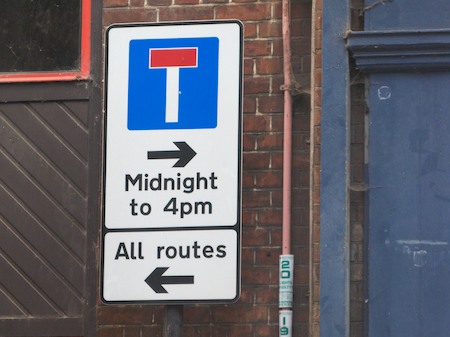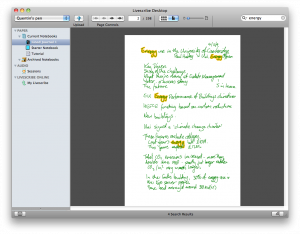…is a snippet from Frank Zappa:
Information is not knowledge. Knowledge is not wisdom. Wisdom is not truth.
…is a snippet from Frank Zappa:
Information is not knowledge. Knowledge is not wisdom. Wisdom is not truth.
Sometimes, just sometimes, I wonder whether I’m getting a glimpse of the future. I wondered that about the early Google Wave videos, but, so far at least, for all the technical cleverness, the future leaves something to be desired. We shall see.
On the subject of Google, though, this post may or may not turn out to be a momentous..errm… moment for me. Because this is the first thing I’ve written using their Chrome OS. I’m running it on my Acer Inspiron One netbook, booting from a USB drive using the very handy images created by a student known as Hexxeh, who seems to have been such a success that his site is currently down.
So far it’s been very easy to get going, amazingly fast to boot even from my elderly USB stick, and pretty nice to use.
Something tells me this may not be the last post I make using this system…
Two great TED talks for you this morning:
Richard Dawkins, speaking in the States, on atheism, especially in the context of American politics.
Hans Rosling, speaking in India, on the rise of Asia – statistics doesn’t get much more fun than this.
Both of these are both very funny and very informative, and made more relevant because of the audience in each case. You can use the search box on the right to find some more of my past recommendations from the same speakers.
Coventry isn’t as bad as you might think. No, really, it isn’t. I worked and lived in the city for over a year just after school and, as far as I can remember, it was just fine. On the other hand, I was young, and hadn’t much experience of living anywhere else, so maybe I just didn’t know any better. I can’t say I’ve ever felt a yearning to return…
Well, I’m back again now, manning an exhibition stand at the Ricoh Arena in an unfashionable area to the north of the town. The last time I did the exhibition stand thing was at Olympia – a very much larger event in a very different venue. Then, as I recall, I paid a lot of money to stay in a room so small that putting your suitcase on the floor meant you could no longer walk around the bed.
So what about here?
Here, my exceedingly affordable room is quite a bit bigger than my bedroom at home. It contains a large brass bed, a sofa and a comfy chair or two. An antique wardrobe and an oak chest sit next to the fireplace. I am, in fact, in one of the nicest B&Bs I’ve ever stayed in, a 17th-century haven in the middle of a couple of hundred acres of dairy farm, run by a delightful couple. I can park easily under the trees outside, and the cows gazed thoughtfully at me as I headed out this morning on my way to the exhibition.
So how long did it take me to reach this rural idyll from Coventry’s manufacturing heartland?
Twelve minutes.
Beat that, London.
The publisher asked me to take some pictures of Rose for the Polish translation of The Blackstone Key. I’m quite pleased with this one:

I think part of its appeal for me is the Mona Lisa smile: What is that girl thinking?
On a country walk today, I came across this wonderful beast. It’s hard to get a feel for scale here, but it was very big!
Do you think this is the sort of thing farmers dream of getting when they win the lottery, where others might aspire to Ferrari-ownership?
More rural, autumnal pictures here.
The great thing about travelling, I’ve always thought, is that it makes you realise what you’ve always taken for granted at home. Do light switches go up or down to turn them on? Or do you press them in so that a timer can pop them out again when you’re halfway up the stairs?
One thing I noticed when first visiting the States was how much text is used on road signs compared to here at home. We tend to assume that symbols are better and so will create some complicated series of hieroglyphics to indicate that the road narrows and then turns left, while an American sign would probably say “Road narrows then turns left”.
Symbols do have an advantage if drivers are illiterate, dyslexic, or foreign. And they usually take less space. But they need to be used well. Here’s a sign I pass regularly which, I find, takes some thought:

It faces you as you come to a T-junction, so you at least have time to contemplate it, which is fortunate – it would be more challenging at speed!
For me, as I suspect for many people in this situation, the question I am asking is ‘Can I turn right?’. To the right is a useful route that takes you away from the crowded centre of Cambridge where you’ve just been parked. But it is blocked, a little way down, by bollards which let traffic either in or out of town at different times of day. So what this sign says is that you can always turn right or left, but turning right will lead you to a dead end at certain times. Fine.
However, if you arrive just after lunch thinking, “Can I turn right?”, you see the arrow pointing that way, you see the times, you work out whether you are in that midnight-to-4pm slot and then you think “Hurrah!”, before realising that you’ve worked out the times when you’re not allowed to do that.
I don’t know, maybe it’s just the way my brain works that’s strange. Or maybe it was designed by some local logicians to keep people like me on their toes. I think it’s a Microsoft road sign. Lots of different ways to do things and some of them unnecessarily complex.
How would Apple design this? I think the sign would just have a single elegant left arrow. They’d say, “Sorry, that’s the only way you can go. No right-button clicks here. I know that seems restricting, but trust us, it’s for your own good. And doesn’t this sign look beautiful?”
There’s a nice saying which captures the fundamentals of alternative medicines:
If they worked, they’d be called ‘medicines’.
Over the centuries, medics and academics have carefully examined herbal and folk remedies and the ones that actually did anything useful became part of the standard medical toolkit. The ones that didn’t are now labelled ‘alternative’, though they can of course have a useful placebo effect.
Anyway, I liked this article about an alternative remedy store in Leicester. Nicely done.
Thanks to Sarah McKeon for the link.
 Cantabrigian readers might enjoy a site I’ve just found, Andrew Brett’s Cambridge Back Chat. It’s a fine collection of local history blog posts on a variety of subjects… I, for one, didn’t know that Mitcham’s Corner was named after a clothes shop that used to stand there. Here’s another view.
Cantabrigian readers might enjoy a site I’ve just found, Andrew Brett’s Cambridge Back Chat. It’s a fine collection of local history blog posts on a variety of subjects… I, for one, didn’t know that Mitcham’s Corner was named after a clothes shop that used to stand there. Here’s another view.
The entry I enjoyed most, though, is a very pleasing account of a Bleriot-pattern monoplane landing on Parker’s Piece in 1911.
The full piece is here, and I recommend reading the whole thing, but here’s an extract:
At last Mr Moorhouse gave the word “”Let go,”” and the machine darted forward across the turf at a great pace, heading slightly to the left of the electric light standard in the centre of the Piece. After running about 120 yards the machine was seen to be rising. The wheels were lifting off the grass, and the whole structure was inclining gently upwards. A few yards and she was wholly clear of the ground, and soaring gracefully upwards. It was a beautiful and a wonderful sight to see how the slender fabric seemed to be converted from a thing of earth, struggling as it were to free itself from the invisible bonds that held it down, into a thing of grace and beauty, fairy-like, almost ethereal, freed from grosser things, that seemed to glide through the air as if it were in its native element and to exalt in its freedom from the trammels of earth. There was something awesome in the sight. One seemed to be looking on at the birth of some strange new thing of wondrous possibilities – the dawn of a new era in the history of mankind.
Ah, local papers were worth reading back then!
Things are going well at Camvine.
Of course, we’ve had the usual trials and tribulations that any startup company goes through, exacerbated by the worst economy for decades in which to try and launch a new company with a new product! But we now have an excellent system in our CODA platform, and customers are starting to buy it and deploy it: you might well find yourself in a school corridor, garden centre, industrial factory, hospital waiting room, conference centre, or university faculty, and find yourself looking at information displayed on our internet-connected CODA screens.
So I’m now starting the fun process of raising further investment to take the company to the next stage. In preparation for this, I’ve been picking the brains of VCs, angel investors, executives and other knowledgeable people about the current state of the investment market, and thought I’d note down a few miscellaneous things I’ve heard.
This is a million miles from being a statistically-valid survey. It’s based on a small number of discussions so far. But I offer them in case they’re useful to others in a similar situation, and would welcome comments and further thoughts from others:
Any VC fund that’s been around for a while is likely to have companies already in its portfolio that have been financially challenged over the last couple of years. They may have to support those with extra funding at the moment, rather than taking on new investments. The best opportunities are therefore coming from funds that raised their capital just before the downturn, and haven’t yet spent it all. Even some of those are being cannibalised to support earlier investments. Different funds have different degrees of freedom to do this, but in general it seems to be a common issue.
For those of you who don’t speak VC – I myself am far from fluent – let me attempt to translate. One VC told me that the average time between putting money into a company and some sort of ‘exit’ (when they get their money back) has lengthened – it’s now about eight years. Since many funds operate with a ten-year lifespan, that doesn’t give them much room to manoeuvre. They need to have invested pretty quickly after the start of the fund to be able to tidy things up before the end, and remember that the eight year figure is an average. Some exits will take much longer.
As a result, many are investing in companies that are a bit more mature, even though the potential gains are smaller for the VC, simply to reduce this timespan. This isn’t such good news for startups.
 Or rather, they’re coming back. Mark Littlewood gathered some statistics together in a very interesting post recently.
Or rather, they’re coming back. Mark Littlewood gathered some statistics together in a very interesting post recently.
The numbers suggest that venture investments in the US, in particular, tumbled dramatically from a peak in mid-2007 to a nadir at the end of 2008, but are rebounding with equal gusto now. Even back in January an executive bubbled enthusiastically to me on the phone. “Here in California it feels as if the recession finished six months ago!” She may be right, but others have told me there’s precious little appetite at present for investing in European companies, so those of us on this side of the pond need to look for funds closer to home.
Mark’s statistics also suggest that European deals have fluctuated much less during this period than might have been expected, and certainly less than the US, though the UK perhaps more than anywhere else has followed the American rollercoaster ride. That’s the special relationship for you.
Doing a deal with a VC has always been a somewhat Faustian affair, and even if you avoid actually selling your soul to them, you may need to sell your shirt to pay your lawyers. One long-established Cambridge VC firm who shall remain nameless became something of a local laughing stock recently when they presented a modest-sized company with a term sheet that ran to 290 pages! But the VC route can be hard to avoid if you’re needing to grow fast.
I’ve generally worked on a rough rule of thumb that you can raise about £600K, maybe a bit more, from angel investors or groups of angels, and that VCs start to be interested once you get over about £1.5M. A million pounds is therefore the hardest amount to raise, and you either need to do it in smaller chunks or present a bigger, more dramatic vision, get more funding, and suffer more dilution than you might want at this stage. That, at least, has been my thinking.
But I was very encouraged when speaking to two separate CEO friends recently, each of them running a company which must have taken a few million in funding, to discover that they had both done it entirely on angel funding, sometimes with the help of government grants. Camvine has been blessed thus far with excellent angel investors who have been supportive at the right times and also asked the difficult questions when they needed to be asked. Angels can also generally move much faster than VCs when timing is tight. The idea that such a model might be something that could be extended much further than I had previously imagined was most encouraging.
So, for now, we’re expecting to raise this next round from individuals rather than institutions. I’m hoping that people will have realised their savings aren’t earning any interest in the bank, and that now is a great time to be investing in companies who have a product to sell as the economy starts to turn upwards again. (Though I’d also be keen to talk to any VCs who want to prove me wrong on any of the above assertions!)
Hope this is useful to somebody out there!
Back in February I wrote about my latest gadget – the LiveScribe Pulse pen. I’ve been using it extensively since then and am very pleased with it.
But I’ve just discovered that the update to the Mac software I installed a month ago has a very significant new feature: search. Yes, it recognises enough of your writing to do a remarkably good job at searching it. Anyone who knows my writing knows that this is no mean feat.

Of course, this is the easy way to do handwriting recognition: you don’t actually have to transcribe it, you just have to work out a few possible interpretations which might match, with various degrees of probability, the thing being searched for.
It’s the same technique we used to search video mail archives and TV broadcasts back at ORL… you didn’t have to recognise the speech perfectly, you just had to get close enough that when someone searched for a word you could list the things that might be a match in rough order of probability.
It’s still incredibly useful, though!
A lovely periodic table from Make magazine.
“Could you pass the salt? It’s over there near Bromium…”
Thanks to @adamnieman for the tweet.
© Copyright Quentin Stafford-Fraser
Recent Comments